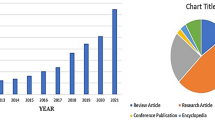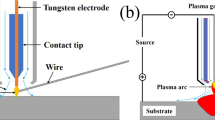Abstract
Hybrid car bodies can be used to exploit the comparative advantages of steels and aluminum alloys for car lightweighting. This development hinges on the deployment of effective hybrid joining technologies. Hybrid welding with transition joints between 1.35-mm-thick DP1000 dual-phase steel sheets and 2.5-mm-thick 6106 aluminum alloy sheets is here investigated. The transition joints are fabricated by explosion welding, with a titanium interlayer. The aluminum alloy sheet, the transition joint and the steel sheet are butt joined by arc welding, with appropriate fillers. The overall tensile strength of the hybrid joint is about two-thirds of the tensile strength of the homologous arc-welded joint fabricated by using the same aluminum alloy sheet, and it is not significantly affected by corrosion in still synthetic seawater.




















Similar content being viewed by others
References
M. Goede, M. Stehlin, L. Rafflenbeul, G. Kopp, and E. Beeh, Super Light Car—Lightweight Construction Thanks to a Multi-material Design and Function Integration, Eur. Transp. Res. Rev., 2009, 1(1), p 5
W.J. Joost, Reducing Vehicle Weight and Improving US Energy Efficiency Using Integrated Computational Materials Engineering, JOM J. Miner. Metals Mater. Soc., 2012, 64(9), p 1032–1038
T.A. Barnes and I.R. Pashby, Joining Techniques for Aluminium Spaceframes Used in Automobiles: Part II—Adhesive Bonding and Mechanical Fasteners, J. Mater. Process. Technol., 2000, 99(1-3), p 72–79
P. Groche, S. Wohletz, M. Brenneis, C. Pabst, and F. Resch, Joining by Forming—A Review on Joint Mechanisms, Applications and Future Trends, J. Mater. Process. Technol., 2014, 214(10), p 1972–1994
X. He, A Review of Finite Element Analysis of Adhesively Bonded Joints, Int. J. Adhes. Adhes., 2011, 31(4), p 248–264
A. Gullino, P. Matteis, and F. D’Aiuto, Review of Aluminum-to-Steel Welding Technologies for Car-Body Applications, Metals, 2019, 9(3), p 315
S. Ohhama, T. Hata, T. Yahaba, T. Kobayashi, T. Miyahara, M. Sayama, Application of an FSW Continuous Welding Technology for Steel and Aluminum to an Automotive Subframe. SAE Technical Paper, No. 2013-01-0372, 2013
S. Huland, M. Moller, M. Franke, and T. Vakalopoulos, The Electrification of the Passat, the GTE. Viavision, Verlag Rommerskirchen, Remagen, 2015
B. Visnic, GM Prepping Industry-First Steel-to-Aluminum Welding Process. Automotive Engineering, 2016
L.H. Shah and M. Ishak, Review of Research Progress on Aluminum-Steel Dissimilar Welding, Mater. Manuf. Process., 2014, 29(8), p 928–933
F. Findik, Recent Developments in Explosive Welding, Mater. Des., 2011, 32(3), p 1081–1093
L. Tricarico and R. Spina, Experimental Investigation of Laser Beam Welding of Explosion-Welded Steel/Aluminum Structural Transition Joints, Mater. Des., 2010, 31(4), p 1981–1992
J.H. Han, J.P. Ahn, and M.C. Shin, Effect of Interlayer Thickness on Shear Deformation Behavior of AA5083 Aluminum Alloy/SS41 Steel Plates Manufactured by Explosive Welding, J. Mater. Sci., 2003, 38(1), p 13–18
S.M. Aceves, F. Espinosa-Loza, J.W. Elmer, and R. Huber, Comparison of Cu, Ti and Ta Interlayer Explosively Fabricated Aluminum to Stainless Steel Transition Joints for Cryogenic Pressurized Hydrogen Storage, Int. J. Hydrog. Energy, 2015, 40(3), p 1490–1503
B.B. Sherpa, A. Upadhyay, S. Kumar, P.D. Kumar, and A. Agarwal, Examination of Joint Integrity in Parallel Plate Configuration of Explosive Welded SS-Al Combination, Mater. Today Proc., 2017, 4(2), p 1260–1267
J. Banker, A. Nobili, Aluminum-Steel Electric Transition Joints, Effects of Temperature and Time Upon Mechanical Properties, in Light Metals, Proceedings of 131st TMS Annual Meeting, Seattle, WA, USA, 2002
A. Nobili and D. Gauthier, Specification Number NC 630a, Nobelclad Europe SA, Rivesaltes, 2011
W.D. Finnegan, Steel-to-Aluminum Transition Joint. U.S. Patent No 3,495,319, 1970
L. Hofmann, Material Data Sheet: FERAN, Wickeder Westfalenstahl GmbH, Wickede, 2016
P. Russo Spena, F. D’Aiuto, P. Matteis, and G. Scavino, Dissimilar Arc Welding of Advanced High-Strength Car-Body Steel Sheets, J. Mater. Eng. Perform., 2014, 23(11), p 3949–3956
P. Russo Spena, P. Matteis, and G. Scavino, Dissimilar Metal Active Gas Welding of TWIP and DP Steel Sheets, Steel Res. Int., 2015, 86(5), p 495–501
G. Cam and G. Ipekoglu, Recent Developments in Joining of Aluminum Alloys, Int. J. Adv. Manuf. Technol., 2017, 91(5–8), p 1851–1866
B. Gungor, E. Kaluc, E. Taban, and S.I.K. Aydin, Mechanical and Microstructural Properties of Robotic Cold Metal Transfer (CMT) Welded 5083-H111 and 6082-T651 Aluminum Alloys, Mater. Des., 2014, 54, p 207–211
EN 10346, Continuously Hot-Dip Coated Steel Flat Products for Cold Forming—Technical Delivery Conditions, European Committee for Standardization, Brussels, 2015
EN 573-3, Aluminium and Aluminium Alloys—Chemical Composition and Form of Wrought Products—Part 3: Chemical Composition and Form of Products, European Committee for Standardization, Brussels, 2013
H.T. Zhang, J.C. Feng, P. He, B.B. Zhang, J.M. Chen, and L. Wang, The Arc Characteristics and Metal Transfer Behaviour of Cold Metal Transfer and Its Use in Joining Aluminium to Zinc-Coated Steel, Mater. Sci. Eng. A, 2009, 499(1–2), p 111–113
ISO 14341, Welding Consumables—Wire Electrodes and Weld Deposits for Gas Shielded Metal Arc Welding of Non Alloy and Fine Grain Steels—Classification, International Organization for Standardization, Geneva, 2010
ISO 18273, Welding Consumables—Wire Electrodes, Wires and Rods for Welding of Aluminium and Aluminium Alloys—Classification, International Organization for Standardization, Geneva, 2015
E. Gaines and J. Banker, Shipboard Aluminum/Steel Welded Transition Joints: Evaluations and Improvements, J. Ship Prod., 1991, 7(03), p 188–199
ISO/DIS 11845 (draft standard), Corrosion of Metals and Alloys—General Principles for Corrosion Testing, International Organization for Standardization, Geneva, 2019
ISO 11845, Corrosion of Metals and Alloys—General Principles for Corrosion Testing, International Organization for Standardization, Geneva, 1995
ISO 4136, Destructive Tests on Welds in Metallic Materials—Transverse Tensile Test, International Organization for Standardization, Geneva, 2012
ISO 6892-1, Metallic Materials—Tensile Testing—Part 1: Method of Test at Room Temperature, International Organization for Standardization, Geneva, 2016
ASTM E3, Standard Guide for Preparation of Metallographic Specimens, ASTM International, West Conshohocken, 2017
ASTM E407, Standard Practice for Microetching Metals and Alloys, ASTM International, West Conshohocken, 2015
ISO 6507-1, Metallic Materials—Vickers Hardness Test—Part 1: Test Method, International Organization for Standardization, Geneva, 2018
R.F. Ashton, R.P. Wesley, and C.R. Dixon, The Effect of Porosity on 5086-H116 Aluminum Alloy Welds, Weld. J., 1975, 54(3), p 95s–98s
R.J. Shore and R.B. McCauley, Effects of Porosity on High Strength Aluminum 7039, Weld. J., 1970, 49(7), p 311s–321s
J.F. Rudy and E.J. Rupert, Effects of Porosity on Mechanical Properties of Aluminum Welds, Weld. J., 1970, 49(7), p 322s–336s
Acknowledgments
A. Riolo and A. D’Aprile contributed to this work during the preparation of their M.Sc dissertations, L. Piovano during the preparation of his B.Sc. dissertation and J. Guilbard during his traineeship project, all at the Politecnico di Torino (Turin Technical University), Torino, Italy. D. Gautier (NobelClad Europe SAS, Perpignan, France) contributed to this work with useful discussion on the explosion-welding process.
Author information
Authors and Affiliations
Corresponding author
Additional information
Publisher's Note
Springer Nature remains neutral with regard to jurisdictional claims in published maps and institutional affiliations.
Rights and permissions
About this article
Cite this article
Matteis, P., Gullino, A., D’Aiuto, F. et al. Welding between Aluminum Alloy and Steel Sheets by Using Transition Joints. J. of Materi Eng and Perform 29, 4840–4853 (2020). https://doi.org/10.1007/s11665-020-04595-2
Received:
Revised:
Published:
Issue Date:
DOI: https://doi.org/10.1007/s11665-020-04595-2




